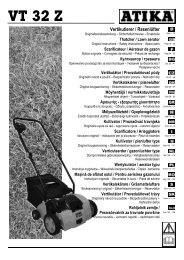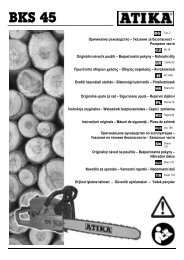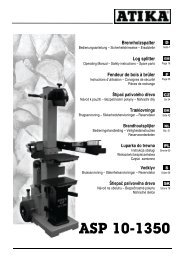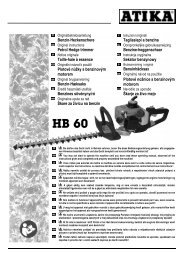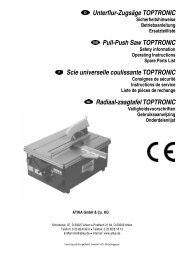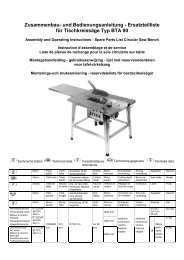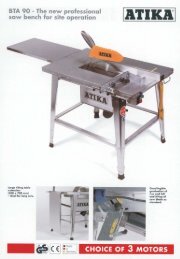Create successful ePaper yourself
Turn your PDF publications into a flip-book with our unique Google optimized e-Paper software.
CHECKING THE IGNITION SPARK<br />
1. Pull off the spark plug connector and clean the connector<br />
area.<br />
2. Unscrew the spark plug with a spark plug wrench.<br />
3. Use an insulated pair of tongs to press the spark plug<br />
against the engine body (away from the spark plug hole).<br />
4. Put the throttle lever to the position .<br />
5. Pull the cranking handle.<br />
If there is no spark visible between the electrodes, the spark<br />
plug may be defective.<br />
SILENCER / EXHAUST OUTLET<br />
1. Check the silencer on a regular basis and Clean the<br />
exhaust outlet on a regular basis.<br />
Do not clean the silencer when the engine ist hot. Danger of<br />
burning!<br />
DJUSTING THE IDLE SPEED:<br />
(to be performed only by customer service)<br />
The carburetor is factory-set to the correct idle speed so<br />
that the correct fuel-air mixture is fed to the engine.<br />
In the cases below the carburetor (idle speed) has to be<br />
corrected:<br />
- Speed too hight<br />
- Erratic running or lack of acceleration (idle speed too<br />
low)<br />
- Adjustment to weather conditions and temperatures<br />
An incorrect carburetor adjustment results in severe<br />
engine damages. Do not continue working with the<br />
device in such a condition.<br />
MAINTENANCE / STORAGE<br />
ADJUSTMENTS ON THE THROTTLE CABLE:<br />
(to be performed only by customer service)<br />
The throttle cable is attached to the engine and product in the<br />
factory and needs no adjustment.<br />
In the cases below the throttle cable has to be corrected:<br />
- The engine continues to run although the throttle lever is in<br />
the STOP position.<br />
- The engine does not start although the throttle lever is in the<br />
CLOSED position.<br />
- Erratic running or poor speeding up.<br />
<strong>7.</strong> STORAGE<br />
STORING THE ENGINE<br />
Storage preparations<br />
Proper <strong>storage</strong> preparation is important to keep your engine in a<br />
flawless functional condition. The following steps will help prevent<br />
rust and corrosion. Rust and corrosion not only affect the function<br />
and the appearance of your engine but also make starting it after<br />
<strong>storage</strong> more difficult.<br />
Cleaning<br />
If the engine has been running, it must cool down for at least half<br />
an hour before cleaning it. Clean all exterior surfaces, repair<br />
damaged paint coat areas and protect other areas that may<br />
possible rust with a thin oil film.<br />
� Spraying off the engine with a garden hose or pressure<br />
cleaner may cause water to enter the openings of air filter or<br />
silencer. Water in the air filter will penetrate it; water entering<br />
through the air filter or silencer may enter the cylinder and<br />
damage the engine.<br />
� Water coming into contact with a hot engine may cause<br />
damage to this engine. If the engine has been running, it<br />
must cool down for at least half an hour before cleaning it.<br />
Fuel<br />
Gasoline/petrol oxidizes and its quality deteriorates during<br />
extended <strong>storage</strong>. Old gasoline makes starting more difficult and<br />
leaves deposits that clog the fuel system. If the quality of the<br />
gasoline deteriorates during <strong>storage</strong>, maintenance measures or<br />
the replacement of the carburettor or other fuel components may<br />
become necessary.<br />
The duration during which gasoline may remain in the fuel tank<br />
and the carburettor without causing malfunctions depends on the<br />
grade of gasoline, the <strong>storage</strong> temperature and the filling level of<br />
the tank. The air in a partially filled tank accelerates the<br />
deterioration of the fuel quality. High <strong>storage</strong> temperatures<br />
accelerate the loss of quality. Problems from gasoline with poor<br />
quality may occur after a few months, but also earlier if, for<br />
example, the gasoline was no longer fresh at the time of fuelling.<br />
The manufacturer’s warranty does not cover any damages on the<br />
fuel system or other engine problems that are caused by<br />
negligent <strong>storage</strong> preparation.<br />
23




